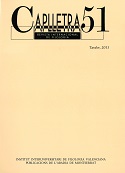Els pseudomossarabismes
DOI:
https://doi.org/10.7203/caplletra.51.4714Keywords:
mossàrab o romandalusí, història del lèxic, etimologia, ictionímia, semàntica diacrònica, contacte de llengües (català, aragonès, occità, italià), lingüística romànica Abstract
Abstract
L’origen de l’ictiònim català «alatxa» i els seus congèneres romànics s’ha atribuït al tractament mossàrab de «ce» del mot llatí «hallece», traspassat a l’àrab. Tanmateix, segons Joan Veny, la distribució geogràfica d’aquest tipus lèxic per les costes de la Mediterrània occidental, on dialectes centromeridionals italoromànics practiquen el canvi «ce» > «tx», convida a replantejar el seu origen geogràfic que seria el litoral de Toscana i Nàpols d’on la isoglossa hauria passat a Ligúria que, per la seva força expansiva, hauria propagat el mot cap a les costes occitanes i d’aquí a les catalanovalencianes fins arribar a Andalusia: seria un exemple més de l’expansió lingüística genovesa que va afectar mots de l’àmbit nàutic i de la pesca.
L’estudi de l’origen de «punxar, punxa i punxó» és una mostra de la necessitat de revisar críticament el concepte de romandalusí o mossàrab. Per a Josep Martines, són mots corrents i antics en català i en aragonès, i coneguts en varietats del castellà oriental; no segueixen l’evolució fonètica esperable en aquestes llengües. Per explicar-los, s’havia recorregut a propostes ad hoc o al mossàrab. La documentació i la fonètica històriques i la geografia lingüística mostren que són vocables coneguts i propis de l’occità, fins i tot allà on «kt» llatí evoluciona vers «it» i no vers la palatal africada. Ens trobem, doncs, davant manlleus antics, potser transmesos inicialment com a termes d’ofici des d’Occitània vers el sud.
 Downloads
Downloads
Downloads
Published
How to Cite
-
Abstract390
-
PDF (Català)258
Issue
Section
License
Authors submitting work to Caplletra for publication must be the legitimate holder of the usage rights. Legitimacy for the purposes of publishing the work must also include images, tables, diagrams and any other materials that may complement the text, whether they are the author of such material or not.
Copyright: on publishing their work in the journal, the author grants Caplletra. Revista Internacional de Filologia usage rights (reproduction, distribution and public communication) for both the paper printed version and for the electronic version.
All work published in Caplletra is covered by the Creative Commons license type Attribution-NonCommercial-NoDerivatives 4.0 (CC BY-NC-ND 4.0).
RESPONSABILITY
Caplletra. Revista Internacional de Filologia does not necessarily identify with the points of view expressed in the papers it publishes.
Caplletra. Revista Internacional de Filologia accepts no responsibility whatsoever for any eventual infringement of intellectual property rights on the part of authors.






